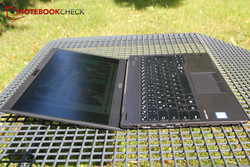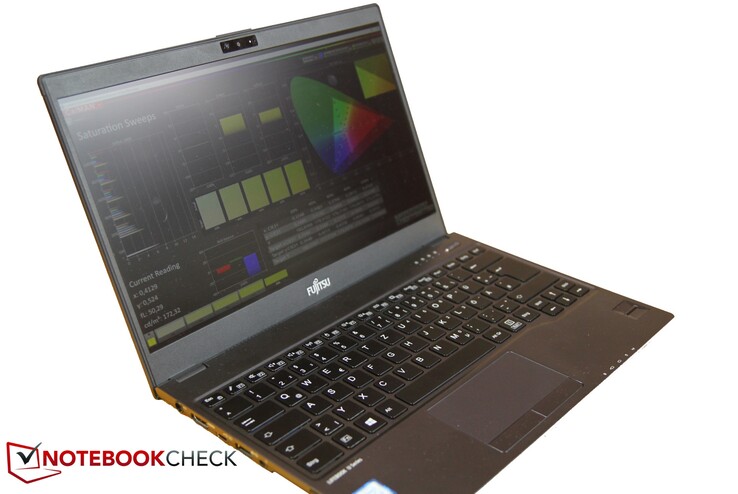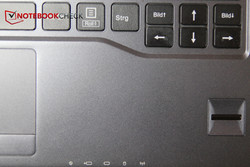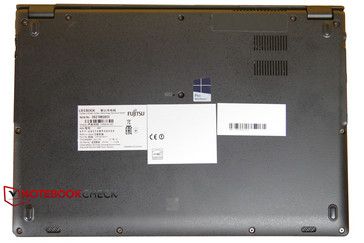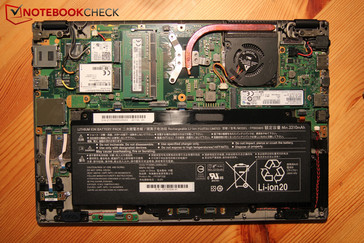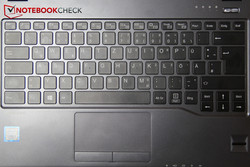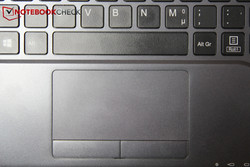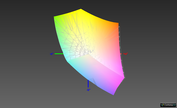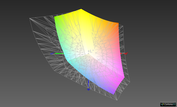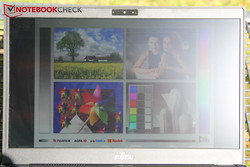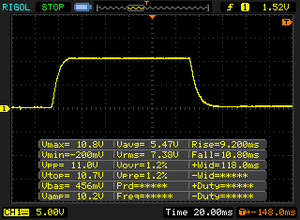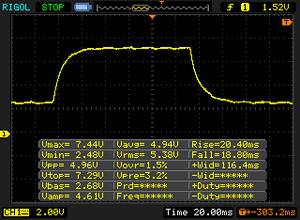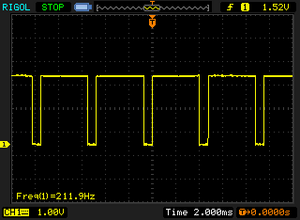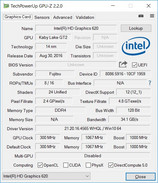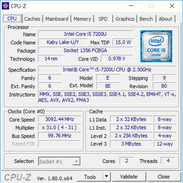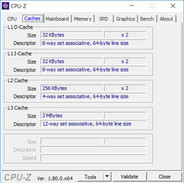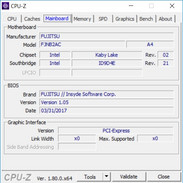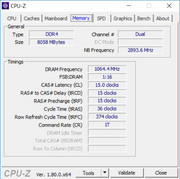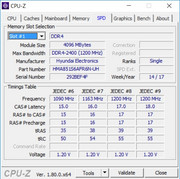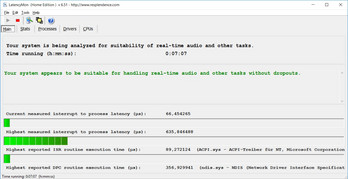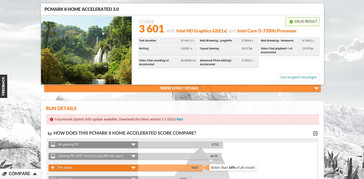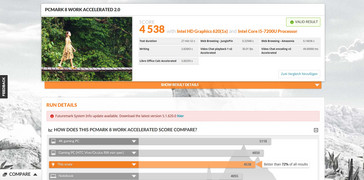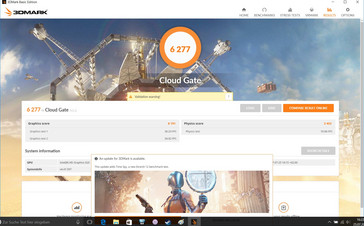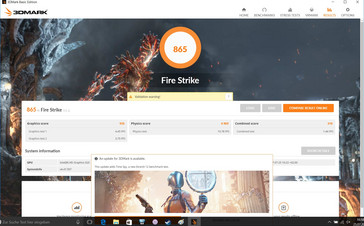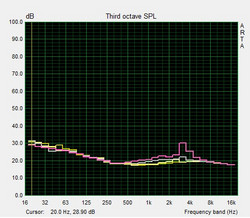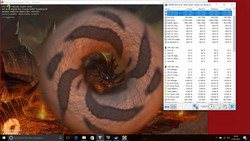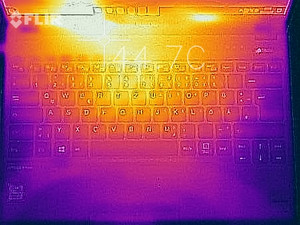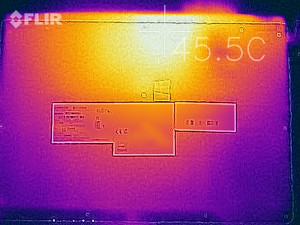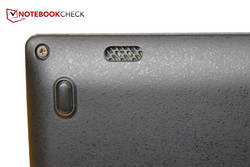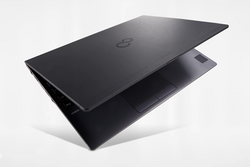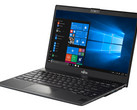Fujitsu LifeBook U937 (Core i5, Full-HD) Laptop Review

For the original German review, click here.
The LifeBook U series is Fujitsu’s top-range business class. We reviewed the LifeBook U747 in March and gave it 87%. Now, Fujitsu has presented another, even slimmer business subnotebook. The display has shrunk from 14 to 13.3 inches and the device itself weighs only 950 grams (~2.1 lb) – less than a carton of milk, which makes it one of the lightest notebooks available. Fujitsu is marketing the device towards businesses and has included a lot of security features such as a palm vein or fingerprint sensor and a smart card slot.
The Fujitsu U937 is available in several configurations with various processors, RAM sizes, storage devices, LTE and Wi-Fi options, fingerprint vs. palm vein sensors etc. We will mention the various hardware options available in each relevant segment.
We will be comparing our test unit with the Asus AsusPro B9440UA, the Lenovo ThinkPad X1 Carbon, the HP Spectre 13, the Dell XPS 13 and the Toshiba Portégé X30. All of these devices boast good portability, an elegant design and good office performance. After this detailed comparison, we will know if our test unit is a business dream come true.
| HP Spectre 13 | Asus AsusPro B9440UA | Dell XPS 13 9360 | Lenovo ThinkPad X1 Carbon | Toshiba Portégé X30 | |
| CPU | Intel Core i7-7500U | Intel Core i5-7200U | Intel Core i5-7200U | Intel Core i5-7200U | Intel Core i7-7600U |
| GPU | Intel HD Graphics 620 | Intel HD Graphics 620 | Intel HD Graphics 620 | Intel HD Graphics 620 | Intel HD Graphics 620 |
| Panel | 13.3 inch 1920x1080 | 14 inch 1920x1080 | 13.3 inch 1920x1080 | 14 inch 1920x1080 | 13.3 inch 1920x1080 |
| RAM | 8 GB LPDDR3-1866 | 8 GB DDR3L-2133 | 8 GB LPDDR3-1866 | 8 GB LPDDR3-1866 | 16 GB DDR4-2400 |
| Price | 1.599 Euro | 1.100 Euro | 1.050 Euro | 1.669 Euro | 2.100 Euro |
Case
According to the manufacturer, the case is made of a very light and robust metal: magnesium. But it seems as if the case is actually made of two kinds of material. One for the top of the base unit, where the keyboard is set into. This is very stable and has a smoother surface than the bottom of the base unit and display cover. The latter is very slim and warps easily – it generally does not appear very stable. The material feels more like plastic with a (magnesium) coating. The keyboard, however, seems very robust and can hardly be twisted at all. The same can be said for the hinges that reliably hold the display cover in place. The subnotebook can be opened to almost 180°.
The colors of the case go from dark gray to black and the surface is decorated with a colored and very slightly raised logo. Overall, the design is simple but elegant – just as you would expect from a business device. The large smart card slot at the front left side and our model's fingerprint sensor at the bottom right of the keyboard are quite noticeable.
Unfortunately, the battery cannot be removed and expansion options seem to be limited as one of the two 4-GB RAM modules is even soldered onto the motherboard. But we will go into that a bit more later on.
The case of the U937 really is one of the smallest of all our comparison devices. If you look at its length and width, only the Dell XPS 13 is a little smaller, but it is also the heaviest comparison device at 1.2 kg (~2.6 lb). The 15.5 mm (~0.61 in) thickness, however, seems to be a standard among the competition. Only the HP Spectre 13 is even slimmer than the rest with an unbelievable 10.4 mm (~0.41 in). But again, that device is a lot larger than the comparison devices, despite having the same display size.
Looking at weight, the Fujitsu, again, is in pole position. 950 grams (~2.1 lb) is simply unbeatable. The Toshiba also weighs only 1 kg (~2.2 lb), but all others are another 100 to 200 g (~3.5 to ~7 oz) heavier. Then of course, you have to add the weight of the power supply (365 g/~13 oz)) which weighs almost half as much as the notebook itself.
Connectivity
Considering that we are talking about an ultra-light notebook, Fujitsu is very liberal in terms of ports and additional features – unlike the AsusPro. The device is equipped with a fully-fledged USB 3.0 Type-A port on either side, one of which even supports “Anytime USB Charge” which lets you charge connected devices even when the computer is turned off. However, the laptop has only one USB 3.1 Type-C port of the first generation, so it does not support Thunderbolt, but has a Power Delivery function.
You can connect an external monitor via the fully-fledged HDMI port that supports resolutions of up to 4096x2160 pixels. The fingerprint sensor will be a welcome addition for fans of biometric data protection and transfer, but there are also models available with a palm vein sensor. The large smart card reader is a great highlight for businesses as it enables you to double protect the device - with a password plus a chip card.
Fujitsu has also done a good job in terms of positioning the ports: USB Type-A ports, which can often require a lot of space, are placed at a short distance to ports that require very little space, such as the audio jack or the USB Type-C port.
SD card reader
We always use the same reference card to test the SD card reader - a Toshiba Exceria Pro SDXC 64 GB UHS-II. The transfer rates that we measured were very good in the copy test and the Fujitsu made first place once again. It beat the Dell by 30%.
The read test brought slightly different results: here, the Dell was faster by 38%, but our Fujitsu U937 still managed second place. The Toshiba took the third place and was behind by 50%. Overall, our test unit did very well.
| SD Card Reader | |
| average JPG Copy Test (av. of 3 runs) | |
| Fujitsu LifeBook U937 (Toshiba Exceria Pro SDXC 64 GB UHS-II) | |
| Dell XPS 13 9360 FHD i5 (Toshiba Exceria Pro SDXC 64 GB UHS-II) | |
| Lenovo ThinkPad X1 Carbon 2017-20HR0021GE (Toshiba Exceria Pro M401) | |
| Toshiba Portege X30-D (PT274U-01N001) (Toshiba Exceria Pro M401) | |
| maximum AS SSD Seq Read Test (1GB) | |
| Dell XPS 13 9360 FHD i5 (Toshiba Exceria Pro SDXC 64 GB UHS-II) | |
| Fujitsu LifeBook U937 (Toshiba Exceria Pro SDXC 64 GB UHS-II) | |
| Toshiba Portege X30-D (PT274U-01N001) (Toshiba Exceria Pro M401) | |
| Lenovo ThinkPad X1 Carbon 2017-20HR0021GE (Toshiba Exceria Pro M401) | |
Communication
The U937 impressed us with its additional communication options. Apart from LAN and Wi-Fi with integrated Bluetooth 4.2, the subnotebook also has a SIM card slot with 4G/LTE support. The latter offers a Sierra Wireless EM7455 LTE modem with 2 LTE antennas and supports downloads of up to 300 MBit/s and uploads of 50 MBit/s
The Wi-Fi module with its two dual-band Wi-Fi antennas from Intel had very good results downstream and, once again, our test unit managed to position itself at the top of our comparison table. The Toshiba’s results were 5% lower, the rest of our comparison devices were between 15 and 30% slower. The Fujitsu’s performance dropped a little upstream and only performed averagely. The winner here was the Lenovo which had an advantage of 30% while the slowest device, the AsusPro, was only 10% behind our Fujitsu U937.
Security
Once again, Fujitsu has tried to go a step further than its competition. In addition to the mandatory Kensington Lock the device is equipped with TPM 2.0 and, depending on the model, either a fingerprint sensor or a palm vein sensor.
The palm vein sensor recognizes the individual pattern of veins and arteries on your palm and fingers via optical sensors and calculations. The security feature works without touch; you simply have to hold your palm over the sensor. We were not able to test this feature as our test unit was a version equipped with a fingerprint sensor, which is positioned at the front right side of the base unit.
The device offers one more security feature: the smart card slot. This enables users to additionally lock their computers, protecting them from strangers and data theft with the help of an ID chip card that needs to be used in combination with user name and password to access the computer. This can be useful especially for company notebooks. Unfortunately, we do not have an ID card with which we could test this function, so it was deactivated.
Accessories
Fujitsu was sparing with its accessories: The comparatively large “Accessory Box” only contained a power supply, a driver DVD and a Quick Start guide. Perhaps it is filled better with the more expensive versions. The driver DVD is quite a surprise as the slim device does not have an optical drive: You would have to connect an external drive or use a second computer in order to make use of the DVD. Asus has done a better job and equipped its device with a bag and port replicator.
The manufacturer does offer some additional accessories on its website. You can take a look at the available accessories here.
Maintenance
Ultra and subnotebooks rarely have a maintenance hatch or exchangeable battery and neither does the Fujitsu U937. The cover of the base unit is fixed with 12 Phillips screws that can be removed easily and there are no hidden screws. Once the screws have been removed the entire cover can be taken off and you can access all components such as the battery, the cooling fan, RAM, SSD etc. This is a great advantage of the Fujitsu and you should have no difficulties cleaning the cooling fan or changing some components.
Warranty
The Japanese manufacturer offers a one-year international warranty, and replacement parts are supposed to be available for 5 years after the end of the product life. Additionally, the manufacturer offers regular product services.
Please see our Guarantees, Return policies and Warranties FAQ for country-specific information.
Input Devices
Keyboard
The normal keys are 19 mm (~0.75 in) wide and have a key travel of 1.2 mm (~0.05 in). As usual, the F-keys are a little smaller. It took us a while to get used to the short travel, which also makes the pressure point a little firmer. After that, typing was easy. There are clear gaps between all keys, which is why the keys are so small. The font is easy to read.
The stable wrist rest means that the keyboard does not bend noticeably while typing. The volume of the keys while typing is still OK. It can be a bit bothersome in quiet surroundings, particularly as the space bar is a little louder than the rest and does not give an impression of high quality.
The Fn key offers the usual special functions, but the device lacks keyboard backlighting. This is not available even optionally, which really is a No-Go in this price range. There are some special functions connected to the f keys. This means that pressing the F4 key, for example, increases the volume, but it also means that if you want to close a window you have to press FN+ALT+F4, which is rather complicated and takes some getting used to.
The power button is at the top right side and luckily is not directly integrated with the keyboard. The keyboard is splash-proof.
Touchpad
The touchpad of our device's sister model LifeBook U747 was not very convincing and the same can be said for the current model. Gliding is OK, but the touchpad is rather small due to the separate keys. Sometimes it took several attempts before the touchpad reacted to your clicks; it is not very sensitive.
The touchpad is not an official precision touchpad. It registers two-finger gestures quite well and you can flip though open apps with three fingers, but other three or four-finger gestures did not work in our test; and you would have trouble using these gestures anyway due to the limited space.
The touchpad keys do not seem to be of particularly high quality and especially the left key rattles even just gliding over to it from the right key. The clicking sounds are a little loud too and should be improved.
Display
Fujitsu has equipped our test unit with a full HD IPS panel from Sharp. The manufacturer claims a viewing angle of 85% from all sides. The display is matte, but there is also a version with a glossy touch display.
The maximum brightness is at 383 cd/m2 and could theoretically beat its competition. Unfortunately, brightness distribution is at only 81%, which is the worst result of all comparison devices, which means the screen "only" reaches an average brightness of 343 cd/m2. Our test unit still manages to reach second place behind the HP Spectre.
Our device's display is the only one out of all comparison devices that uses PWM to regulate screen brightness. The display turns on and off at a frequency of over 200 Hz, which might be a problem for sensitive users. However, it only uses PWM at a brightness of 20% or below. We noticed no backlight bleeding during our review.
| |||||||||||||||||||||||||
Brightness Distribution: 81 %
Center on Battery: 350 cd/m²
Contrast: 1070:1 (Black: 0.33 cd/m²)
ΔE ColorChecker Calman: 3.5 | ∀{0.5-29.43 Ø4.78}
ΔE Greyscale Calman: 4.9 | ∀{0.09-98 Ø5}
98.1% sRGB (Argyll 1.6.3 3D)
63.5% AdobeRGB 1998 (Argyll 1.6.3 3D)
70.4% AdobeRGB 1998 (Argyll 3D)
98% sRGB (Argyll 3D)
68.6% Display P3 (Argyll 3D)
Gamma: 2.21
CCT: 7136 K
| Fujitsu LifeBook U937 Sharp SHP1483, LQ133M1JW28, , 1920x1080, 13.3" | Asus ASUSPRO B9440UA-GV0100T AU Optronics AUO353D / B140HAN03.5, , 1920x1080, 14" | Lenovo ThinkPad X1 Carbon 2017-20HR0021GE B140HAN03_1, , 1920x1080, 14" | HP Spectre 13-v131ng CMN1374, , 1920x1080, 13.3" | Dell XPS 13 9360 FHD i5 Sharp SHP1449 LQ133M1, , 1920x1080, 13.3" | Toshiba Portege X30-D (PT274U-01N001) Toshiba TOS508F, , 1920x1080, 13.3" | |
|---|---|---|---|---|---|---|
| Display | -8% | -11% | -8% | -27% | -4% | |
| Display P3 Coverage (%) | 68.6 | 64 -7% | 61.6 -10% | 64.6 -6% | 48.94 -29% | 66.4 -3% |
| sRGB Coverage (%) | 98 | 89.1 -9% | 87.6 -11% | 88.8 -9% | 73.3 -25% | 93.5 -5% |
| AdobeRGB 1998 Coverage (%) | 70.4 | 65.2 -7% | 62.6 -11% | 64.8 -8% | 50.5 -28% | 66.6 -5% |
| Response Times | -39% | -37% | -41% | -25% | -21% | |
| Response Time Grey 50% / Grey 80% * (ms) | 39.2 ? | 48.8 ? -24% | 48 ? -22% | 46 ? -17% | 32.8 ? 16% | 36.8 ? 6% |
| Response Time Black / White * (ms) | 20 ? | 30.8 ? -54% | 30.4 ? -52% | 33 ? -65% | 33.2 ? -66% | 29.6 ? -48% |
| PWM Frequency (Hz) | 211.9 ? | |||||
| Screen | -31% | 5% | -10% | -11% | 9% | |
| Brightness middle (cd/m²) | 353 | 319 -10% | 278 -21% | 404 14% | 351.2 -1% | 332.6 -6% |
| Brightness (cd/m²) | 347 | 294 -15% | 271 -22% | 382 10% | 325 -6% | 323 -7% |
| Brightness Distribution (%) | 81 | 87 7% | 91 12% | 91 12% | 89 10% | 86 6% |
| Black Level * (cd/m²) | 0.33 | 0.26 21% | 0.16 52% | 0.35 -6% | 0.195 41% | 0.28 15% |
| Contrast (:1) | 1070 | 1227 15% | 1738 62% | 1154 8% | 1801 68% | 1188 11% |
| Colorchecker dE 2000 * | 3.5 | 7.1 -103% | 4.5 -29% | 5.37 -53% | 7.4 -111% | 2.6 26% |
| Colorchecker dE 2000 max. * | 6.9 | 13.7 -99% | 8.4 -22% | 9.46 -37% | 9.08 -32% | 6.7 3% |
| Greyscale dE 2000 * | 4.9 | 9.61 -96% | 3.2 35% | 6.44 -31% | 6.71 -37% | 2.5 49% |
| Gamma | 2.21 100% | 2.33 94% | 2.02 109% | 2.52 87% | 2.74 80% | 2.12 104% |
| CCT | 7136 91% | 6021 108% | 7042 92% | 6738 96% | 7222 90% | 6720 97% |
| Color Space (Percent of AdobeRGB 1998) (%) | 63.5 | 54.01 -15% | 57 -10% | 58 -9% | 50.48 -21% | 62 -2% |
| Color Space (Percent of sRGB) (%) | 98.1 | 83.02 -15% | 87.5 -11% | 89 -9% | 73.31 -25% | 94 -4% |
| Total Average (Program / Settings) | -26% /
-27% | -14% /
-4% | -20% /
-14% | -21% /
-16% | -5% /
2% |
* ... smaller is better
The black value is not great at 0.33 cd/m² and the contrast of 1070:1 is commendable, but still not as good as the other displays in the comparison devices. This loss of points could have been avoided.
Apart from good brightness values, the device also has good ColorChecker and gray scale values, offers acceptable reaction times and has great color space coverage (sRGB 98.1%, AdobeRGB: 63.1%).
Subjectively there is not much to criticize: the image seems sharp, colors are rich, black appears dark and it can handle fast scrolling.
The good brightness value of 347 cd/m2 and the matte surface mean that the office notebook can be used outdoors quite well. The maximum brightness remains the same in battery mode and the screen can be read very well under an overcast sky but you can even continue working in direct sunlight. You can see the worst case in the image below: we positioned the screen so that the sun shone directly at it.
Display Response Times
| ↔ Response Time Black to White | ||
|---|---|---|
| 20 ms ... rise ↗ and fall ↘ combined | ↗ 9.2 ms rise | |
| ↘ 10.8 ms fall | ||
| The screen shows good response rates in our tests, but may be too slow for competitive gamers. In comparison, all tested devices range from 0.1 (minimum) to 240 (maximum) ms. » 42 % of all devices are better. This means that the measured response time is similar to the average of all tested devices (20.2 ms). | ||
| ↔ Response Time 50% Grey to 80% Grey | ||
| 39.2 ms ... rise ↗ and fall ↘ combined | ↗ 20.4 ms rise | |
| ↘ 18.8 ms fall | ||
| The screen shows slow response rates in our tests and will be unsatisfactory for gamers. In comparison, all tested devices range from 0.165 (minimum) to 636 (maximum) ms. » 59 % of all devices are better. This means that the measured response time is worse than the average of all tested devices (31.6 ms). | ||
Screen Flickering / PWM (Pulse-Width Modulation)
| Screen flickering / PWM detected | 211.9 Hz | ≤ 20 % brightness setting | |
The display backlight flickers at 211.9 Hz (worst case, e.g., utilizing PWM) Flickering detected at a brightness setting of 20 % and below. There should be no flickering or PWM above this brightness setting. The frequency of 211.9 Hz is relatively low, so sensitive users will likely notice flickering and experience eyestrain at the stated brightness setting and below. In comparison: 53 % of all tested devices do not use PWM to dim the display. If PWM was detected, an average of 8108 (minimum: 5 - maximum: 343500) Hz was measured. | |||
Typically for an IPS display, our screen has good viewing-angle stability. The manufacturer states viewing angles of 85° on all sides; the image below shows the display from viewing angles of 45°. Of course the screen loses a little brightness, but the image remains very clear.
Performance
Fujitsu’s U937 is available with various hardware configurations and these can have a big influence on the device’s performance. First of all, the notebook is available with three different processors, which all belong to Intel’s Kaby Lake generation. The processor that our model is equipped with is a Core i5-7200U; the other two options are an i5-7300U and an i7-7600U, which both have higher clock rates.
The test unit is equipped with 8 GB of working memory, but there are other versions with 4 GB and 16 GB. 4 GB of RAM are firmly soldered onto the processor in our model, and the other 4 GB of RAM are connected via a DIMM slot.
Internal storage ranges from 128 GB to 512 GB with six different versions. Two of them have an SSD with a PCIe connection while our model and the other versions have to make do with a SATA III SSD.
Our device is equipped with the HD Graphics 620, integrated into the Kaby Lake processor. As it does not have its own memory, it shares the system RAM.
Overall, our test unit’s components should offer problem-free use in the office. The version with only 4 GB of RAM might not be fit for today’s standards; apart from that CPU, RAM and the SSD should enable good performance for office work and surfing the web.
Processor
Our test unit is equipped with an Intel Core i5-7200U. The processor has two cores and supports Hyperthreading for working up to four threads simultaneously. It clocks at between 2.5 and 3.1 GHz and is a fast processor from Intel’s Kaby Lake series. The processor has an integrated graphics unit, the Intel HD Graphics 620. It has a higher clock rate compared to its predecessor and should be able to support more demanding tasks as well as managing multitasking. You can find more information about the CPU here.
There are two other processor versions for this laptop: the i5-7300U and the i7-7600U. Both are faster, have a higher clock rate and support Intel’s vPro technology. But our test unit should already be able to master all necessary tasks easily.
Apart from the Toshiba and the HP Spectre, all comparison devices are equipped with the same CPU. The Toshiba Portégé X30 has a Core i7-7600U that clocks between 2.8 and 3.9 GHz, which is quite a bit higher than the i5-7200U.
The Fujitsu had no difficulties during our 30-minute Cinebench loop and had a constant clock rate of about 3.1 GHz. There was no throttling and the cores heated up to just under 20 °C (~68°F). The Ultrabook keeps up its performance even on battery. There was no change in the clock rate and the Cinebench score was almost the same as well.
Most comparison devices showed similar results in the Cinebench test, with only 1 to 5% difference – after all, they all have the same processor. Only the HP Spectre can reach better results in the Single CPU test due to its higher clock rate, but falls back in the Multi CPU test. The Fujitsu is somewhere in the middle.
| Cinebench R10 | |
| Rendering Single CPUs 64Bit | |
| HP Spectre 13-v131ng | |
| Lenovo ThinkPad X1 Carbon 2017-20HR0021GE | |
| Fujitsu LifeBook U937 | |
| Rendering Multiple CPUs 64Bit | |
| HP Spectre 13-v131ng | |
| Lenovo ThinkPad X1 Carbon 2017-20HR0021GE | |
| Fujitsu LifeBook U937 | |
System Performance
It is not surprising that our test unit has similar results as its comparison devices, as all models (except for the Toshiba and HP) are equipped with the same CPU and 8 GB of RAM. The slight differences are mainly due to throttling or the SSD.
Only the Toshiba and the HP could set themselves apart from the other devices in the Work Score of the PCMark 8 benchmark, in the Home Score it was the HP and the Lenovo that were ahead by about 5%. But even here, the differences are very small and basically it can be said that all comparison devices have very similar performance.
We have nothing to complain about the performance speed of the Fujitsu LifeBook in everyday working conditions. Starting up the computer as well as working with office and online applications is fast and everything works smoothly without any lagging.
| PCMark 10 - Score | |
| Lenovo ThinkPad X1 Carbon 2017-20HR0021GE | |
| Fujitsu LifeBook U937 | |
| PCMark 8 Home Score Accelerated v2 | 3601 points | |
| PCMark 8 Work Score Accelerated v2 | 4538 points | |
| PCMark 10 Score | 2198 points | |
Help | ||
Storage Devices
Our test unit’s storage comes from a 256-GB SSD from Samsung. The storage device is on 143rd place in our hard drive benchmarks. For more information, click here.
Despite Samsung’s good name as a manufacturer of fast SSDs, this model is not particularly convincing. Of course the SSD is still a lot faster than normal hard drives, but in our direct comparison it could only keep up with the AsusPro. The Toshiba and the HP Spectre in particular had great results in this area, but the Lenovo and Dell also have better results than our Fujitsu.
There is a simple explanation for this difference in performance: While our SSD is connected via SATA III, most of our comparison devices have faster NVMe SSDs with PCIe. There are versions of the Fujitsu LifeBook U937 that are equipped with NVMe SSDs, but these are more expensive.
Anyway, the difference is not particularly important during day-to-day use, unless you have to regularly copy large amounts of data.
| Fujitsu LifeBook U937 Samsung CM871a MZNTY256HDHP | Asus ASUSPRO B9440UA-GV0100T Micron SSD 1100 (MTFDDAV256TBN) | Lenovo ThinkPad X1 Carbon 2017-20HR0021GE Toshiba THNSF5256GPUK | HP Spectre 13-v131ng Samsung PM961 NVMe MZVLW512HMJP | Dell XPS 13 9360 FHD i5 Toshiba NVMe THNSN5256GPUK | Toshiba Portege X30-D (PT274U-01N001) Samsung PM961 MZVLW256HEHP | |
|---|---|---|---|---|---|---|
| CrystalDiskMark 3.0 | -3% | 55% | 107% | 61% | 114% | |
| Read Seq (MB/s) | 509 | 462 -9% | 1277 151% | 1090 114% | 1233 142% | 1270 150% |
| Write Seq (MB/s) | 462.3 | 441.4 -5% | 648 40% | 1088 135% | 733 59% | 1213 162% |
| Read 512 (MB/s) | 385.1 | 323.2 -16% | 972 152% | 753 96% | 1036 169% | 858 123% |
| Write 512 (MB/s) | 228.5 | 398.8 75% | 311 36% | 911 299% | 439.9 93% | 763 234% |
| Read 4k (MB/s) | 34.85 | 26.81 -23% | 34.63 -1% | 57.5 65% | 29.31 -16% | 40.9 17% |
| Write 4k (MB/s) | 90.5 | 87.8 -3% | 128.5 42% | 140.2 55% | 116.9 29% | 143.6 59% |
| Read 4k QD32 (MB/s) | 392.8 | 247.3 -37% | 477.3 22% | 497.1 27% | 479.2 22% | 626 59% |
| Write 4k QD32 (MB/s) | 253.6 | 232.1 -8% | 241.2 -5% | 416 64% | 218.3 -14% | 536 111% |
Graphics
The Fujitsu U937 is not equipped with a dedicated graphics card, but has an Intel HD Graphics 620 integrated into the processor that accesses system RAM as it is not equipped with separate memory. The internal graphics unit is particularly important for decoding current video codecs, but is not so suitable for gaming. Simple games should be playable in low to medium settings, but new and demanding games will not run smoothly, even in the lowest settings.
But these ultra-portable office notebooks are not made for gaming anyway, and the competition has the same integrated graphics unit, although the clock rate varies a little depending on their processors. Only the Toshiba and the HP have a slightly faster processor, so only the clock rate will differ in these devices.
There are not many differences between the results from the synthetic 3DMark benchmarks: The Fujitsu is only minimally better than the Toshiba in the 3DMark 11 despite its better CPU, but both of them are at the bottom of the list, with the other devices performing about 5% better.
We ran the benchmarks Cloud Gate and Fire Strike from 3DMark 2013. The former brought very similar results for all comparison devices - there was only about 1% difference between them all, with the exception of the Lenovo and the Toshiba lagging behind by 6 to 14%. In the Fire Strike, on the other hand, the Lenovo was 11% faster than the Fujitsu. As you can see, the results are quite diverse in these tests, but all devices have a similar performance overall. Not even the HP - and definitely not the Toshiba - can really offer better performance, despite being equipped with better CPUs.
Funnily enough, we were not able to start the 3DMark 11 when the Fujitsu was running on battery. After several attempts the benchmark was aborted and showed an error message. Next, we tried starting the Cloud Gate benchmark from 3DMark 2013. This worked, but the throttling in battery mode caused performance to trop to 4077 points, which is almost 50% worse than on power supply.
| 3DMark 11 Performance | 1628 points | |
| 3DMark Cloud Gate Standard Score | 6277 points | |
| 3DMark Fire Strike Score | 865 points | |
Help | ||
Gaming Performance
Hardly any new and demanding games can be played smoothly on the Fujitsu U937. "The Witcher 3" and "Rise of the Tomb Raider" both had under 20 fps even with the lowest settings; they are basically unplayable. At the most, these results can be used as a means of comparison to the other devices.
Older or less demanding games such as "Rocket League" can be played in low or even medium settings, although you do have to lower the resolution which is quite noticeable. "Rocket League", for example, can be played at 1280 x 720 pixels and in low details at 54 fps. The game even plays relatively smoothly at about 38 fps in full HD resolution and low details. But even here the game can become unplayable in more demanding scenes or with many players.
Compared to the other devices the Fujitsu has good results: we compared the results of “The Witcher 3” and “Rise of the Tomb Raider” and despite not being good enough to actually play the games, its results were the best of all comparison devices. Sometimes it even overtook the HP Spectre, depending on the set resolution and details.
You can take a closer look at the Intel HD Graphics 620 and its performance here. We also have a page on various games including detailed information and benchmark results of many games with various graphics cards.
Overall we can say that none of these devices are made with gaming in mind. If you really want to, you can definitely play older or more modest games in low settings. The differences between the various comparison devices is rather small.
| low | med. | high | ultra | |
|---|---|---|---|---|
| The Witcher 3 (2015) | 13.85 | 8.84 | 4.77 | |
| Rise of the Tomb Raider (2016) | 17.88 | 11.33 | 6.14 | |
| Rocket League (2017) | 54.3 | 24.39 | 15.18 |
Emissions
System Noise
All comparison devices seem to have a similar level of system noise according to our measurements. The Fujitsu is a little louder than average while idling, but is comparatively quiet under load. The Dell XPS is the only model that has really good values; it can be considered the quietest device.
Despite the average-to-good measurements, we were not that happy with the cooling system subjectively. As with all comparison devices, the cooling fans never turn off completely and emit a high-frequency noise even when they are just running along quietly. We noticed this during our test in quiet surroundings and it was particularly annoying under load. But even the quiet Dell has a similar problem.
Noise level
| Idle |
| 30.8 / 30.8 / 31.1 dB(A) |
| Load |
| 32.3 / 35.7 dB(A) |
 | ||
30 dB silent 40 dB(A) audible 50 dB(A) loud |
||
min: | ||
| Fujitsu LifeBook U937 HD Graphics 620, i5-7200U, Samsung CM871a MZNTY256HDHP | Asus ASUSPRO B9440UA-GV0100T HD Graphics 620, i5-7200U, Micron SSD 1100 (MTFDDAV256TBN) | Lenovo ThinkPad X1 Carbon 2017-20HR0021GE HD Graphics 620, i5-7200U, Toshiba THNSF5256GPUK | HP Spectre 13-v131ng HD Graphics 620, i7-7500U, Samsung PM961 NVMe MZVLW512HMJP | Dell XPS 13 9360 FHD i5 HD Graphics 620, i5-7200U, Toshiba NVMe THNSN5256GPUK | Toshiba Portege X30-D (PT274U-01N001) HD Graphics 620, i7-7600U, Samsung PM961 MZVLW256HEHP | |
|---|---|---|---|---|---|---|
| Noise | -0% | 0% | -5% | 6% | 4% | |
| off / environment * (dB) | 30.8 | 29 6% | 29.6 4% | 30.4 1% | 28.4 8% | |
| Idle Minimum * (dB) | 30.8 | 29 6% | 29.6 4% | 30.4 1% | 28.9 6% | 28.4 8% |
| Idle Average * (dB) | 30.8 | 29 6% | 29.6 4% | 30.4 1% | 28.9 6% | 28.4 8% |
| Idle Maximum * (dB) | 31.1 | 29 7% | 32.2 -4% | 30.4 2% | 28.9 7% | 28.4 9% |
| Load Average * (dB) | 32.3 | 36.7 -14% | 34.2 -6% | 40 -24% | 30.9 4% | 33.2 -3% |
| Load Maximum * (dB) | 35.7 | 40.2 -13% | 36.1 -1% | 40 -12% | 33.5 6% | 37.9 -6% |
* ... smaller is better
Temperature
The Fujitsu reached good results in our temperature measurements: while idling, it heated up the least (together with the Dell) and it remained rather cool even under load, although several comparison devices had similar values. Good: Temperatures are evenly distributed on the top and bottom of the base unit. HP and Dell messed up in this respect with normal to good temperatures on the one side, but very high temperatures on the other, which made them loose several rating points.
The Fujitsu heats up particularly on the right side towards the screen while the wrist rest remains comfortably cool. The back of the base unit reaches over 40 °C (~104 °F) under maximum load. This is also where the small ventilation slots are through which excess heat can be transported out of the base unit. Compared to the other devices our test unit had the most balanced heat map.
We did a practical test and the device can be used on your lap even under load. We would recommend covering your legs as the heat can become uncomfortable on bare legs. There should be no problems during normal use, however, and the device always remains cool enough to use it wearing shorts in summer.
The CPU reached temperatures of up to 80 °C (~176 °F) during our extreme stress test. When it reaches this temperature, the clock rate is lowered gradually until the CPU remains between 70 and 80 °C (~158 to 176 °F). In our test with Prime95 and FurMark, the CPU clock rate settled between 1.4 and 1.5 GHz. This kind of throttling is normal and the lowered clock rate is still comparatively good. These kinds of stress loads are unlikely to occur in practice for this kind of device. The cooling fans continue running for quite a while after the stress test to slowly cool down the device.
(±) The maximum temperature on the upper side is 43.4 °C / 110 F, compared to the average of 35.9 °C / 97 F, ranging from 21.4 to 59 °C for the class Subnotebook.
(±) The bottom heats up to a maximum of 41.6 °C / 107 F, compared to the average of 39.3 °C / 103 F
(+) In idle usage, the average temperature for the upper side is 25.3 °C / 78 F, compared to the device average of 30.8 °C / 87 F.
(+) The palmrests and touchpad are cooler than skin temperature with a maximum of 26.4 °C / 79.5 F and are therefore cool to the touch.
(±) The average temperature of the palmrest area of similar devices was 28.2 °C / 82.8 F (+1.8 °C / 3.3 F).
| Fujitsu LifeBook U937 HD Graphics 620, i5-7200U, Samsung CM871a MZNTY256HDHP | Asus ASUSPRO B9440UA-GV0100T HD Graphics 620, i5-7200U, Micron SSD 1100 (MTFDDAV256TBN) | Lenovo ThinkPad X1 Carbon 2017-20HR0021GE HD Graphics 620, i5-7200U, Toshiba THNSF5256GPUK | HP Spectre 13-v131ng HD Graphics 620, i7-7500U, Samsung PM961 NVMe MZVLW512HMJP | Dell XPS 13 9360 FHD i5 HD Graphics 620, i5-7200U, Toshiba NVMe THNSN5256GPUK | Toshiba Portege X30-D (PT274U-01N001) HD Graphics 620, i7-7600U, Samsung PM961 MZVLW256HEHP | |
|---|---|---|---|---|---|---|
| Heat | -0% | -10% | -8% | -5% | -4% | |
| Maximum Upper Side * (°C) | 43.4 | 36.6 16% | 48.5 -12% | 54.2 -25% | 43.4 -0% | 40.6 6% |
| Maximum Bottom * (°C) | 41.6 | 41 1% | 46.1 -11% | 37.7 9% | 49.2 -18% | 40 4% |
| Idle Upper Side * (°C) | 26.5 | 28 -6% | 28.5 -8% | 29 -9% | 26.4 -0% | 30 -13% |
| Idle Bottom * (°C) | 26 | 29 -12% | 27.8 -7% | 27.6 -6% | 26.4 -2% | 29.2 -12% |
* ... smaller is better
Speakers
Considering the small size of the devices, it is hardly surprising that the speakers cannot cater for a big party and that the quality is not that high. The maximum volume is very limited, there is hardly any bass and even rock music sounds unclear, weak and tinny. We would definitely recommend using headphones or external speakers, which you can connect via USB or the combined audio jack.
Fujitsu LifeBook U937 audio analysis
(+) | speakers can play relatively loud (82 dB)
Bass 100 - 315 Hz
(-) | nearly no bass - on average 31.6% lower than median
(+) | bass is linear (3.5% delta to prev. frequency)
Mids 400 - 2000 Hz
(±) | reduced mids - on average 7.3% lower than median
(±) | linearity of mids is average (8.4% delta to prev. frequency)
Highs 2 - 16 kHz
(±) | higher highs - on average 9.2% higher than median
(±) | linearity of highs is average (7% delta to prev. frequency)
Overall 100 - 16.000 Hz
(-) | overall sound is not linear (33.4% difference to median)
Compared to same class
» 95% of all tested devices in this class were better, 1% similar, 4% worse
» The best had a delta of 5%, average was 18%, worst was 53%
Compared to all devices tested
» 92% of all tested devices were better, 1% similar, 7% worse
» The best had a delta of 4%, average was 24%, worst was 134%
Asus ASUSPRO B9440UA-GV0100T audio analysis
(±) | speaker loudness is average but good (78 dB)
Bass 100 - 315 Hz
(±) | reduced bass - on average 9.4% lower than median
(±) | linearity of bass is average (9.6% delta to prev. frequency)
Mids 400 - 2000 Hz
(+) | balanced mids - only 2% away from median
(+) | mids are linear (4.4% delta to prev. frequency)
Highs 2 - 16 kHz
(±) | higher highs - on average 5.3% higher than median
(+) | highs are linear (6.8% delta to prev. frequency)
Overall 100 - 16.000 Hz
(±) | linearity of overall sound is average (16.1% difference to median)
Compared to same class
» 17% of all tested devices in this class were better, 6% similar, 77% worse
» The best had a delta of 7%, average was 21%, worst was 53%
Compared to all devices tested
» 25% of all tested devices were better, 5% similar, 70% worse
» The best had a delta of 4%, average was 24%, worst was 134%
Frequency diagram in comparison (checkboxes can be turned on/off!)
Energy Management
Power Consumption
Once again, our test unit proves how well-balanced it is: There are several rivals that consume more, both while idling and under load. Overall, the Fujitsu remains in the center field without any exceptions. While the Toshiba consumes less power under load, it requires more without load. Only the Dell can be considered more energy-efficient overall.
The narrow 65-watt power supply provides more than enough power and should manage to charge the subnotebook reliably even under maximum load.
| Off / Standby | |
| Idle | |
| Load |
|
Key:
min: | |
| Fujitsu LifeBook U937 i5-7200U, HD Graphics 620, Samsung CM871a MZNTY256HDHP, IPS, 1920x1080, 13.3" | Asus ASUSPRO B9440UA-GV0100T i5-7200U, HD Graphics 620, Micron SSD 1100 (MTFDDAV256TBN), IPS, 1920x1080, 14" | Lenovo ThinkPad X1 Carbon 2017-20HR0021GE i5-7200U, HD Graphics 620, Toshiba THNSF5256GPUK, IPS, 1920x1080, 14" | HP Spectre 13-v131ng i7-7500U, HD Graphics 620, Samsung PM961 NVMe MZVLW512HMJP, IPS UWVA, 1920x1080, 13.3" | Dell XPS 13 9360 FHD i5 i5-7200U, HD Graphics 620, Toshiba NVMe THNSN5256GPUK, IPS, 1920x1080, 13.3" | Toshiba Portege X30-D (PT274U-01N001) i7-7600U, HD Graphics 620, Samsung PM961 MZVLW256HEHP, IPS, 1920x1080, 13.3" | |
|---|---|---|---|---|---|---|
| Power Consumption | -5% | -22% | -16% | 12% | -12% | |
| Idle Minimum * (Watt) | 3.11 | 3.1 -0% | 3.8 -22% | 3.6 -16% | 4.1 -32% | 4.6 -48% |
| Idle Average * (Watt) | 6.1 | 6.1 -0% | 7.1 -16% | 6.4 -5% | 4.2 31% | 7.6 -25% |
| Idle Maximum * (Watt) | 6.75 | 6.8 -1% | 8.3 -23% | 9.2 -36% | 5.1 24% | 8.2 -21% |
| Load Average * (Watt) | 28.9 | 27.4 5% | 34.2 -18% | 34 -18% | 22.1 24% | 23.8 18% |
| Load Maximum * (Watt) | 33.3 | 43.7 -31% | 43.3 -30% | 34.4 -3% | 29.4 12% | 28 16% |
* ... smaller is better
Battery Runtime
To measure maximum battery runtime, we took advantage of Fujitsu's own power-saving tools. For example, we limited CPU performance (low) and activated the Fujitsu energy-saving mode. We set the screen to minimum brightness and put the device under minimum load with the BatteryEater Readers test. With these settings, the slim business partner kept running for 19 hours and 12 minutes, which is a very good result similar to that of the AsusPro and which can only be topped by the Dell.
We used the BatteryEater Classic at maximum performance and brightness plus active Wi-Fi and Bluetooth to measure the other extreme - minimum battery runtime. The device turned off after about 2 hours and 40 minutes. This is a good result and puts it on first place.
After taking a look at these extremes, we turned to the more realistic Wi-Fi test. In this test we measure the average battery runtime while surfing on the internet in the "balanced" mode and at about 150 cd/m2 brightness. Again we made use of Fujitsu's own power-saving tools. When we limited CPU performance to medium and activated the Fujitsu energy-saving mode the device ran for almost 11 hours, another great result that only the Dell can compete with.
More good news: The battery charges quickly and reaches 100% after just one hour.
| Fujitsu LifeBook U937 i5-7200U, HD Graphics 620, 50 Wh | Asus ASUSPRO B9440UA-GV0100T i5-7200U, HD Graphics 620, 48 Wh | Lenovo ThinkPad X1 Carbon 2017-20HR0021GE i5-7200U, HD Graphics 620, 57 Wh | HP Spectre 13-v131ng i7-7500U, HD Graphics 620, 38 Wh | Dell XPS 13 9360 FHD i5 i5-7200U, HD Graphics 620, 60 Wh | Toshiba Portege X30-D (PT274U-01N001) i7-7600U, HD Graphics 620, 48 Wh | |
|---|---|---|---|---|---|---|
| Battery runtime | -14% | -23% | -44% | 4% | -27% | |
| Reader / Idle (h) | 19.2 | 19 -1% | 13.7 -29% | 12 -37% | 21.6 13% | 15 -22% |
| H.264 (h) | 11.9 | 9.6 -19% | 6.1 -49% | |||
| WiFi v1.3 (h) | 10.9 | 8.9 -18% | 9.1 -17% | 6.6 -39% | 11.3 4% | 7.2 -34% |
| Load (h) | 2.7 | 2.1 -22% | 2 -26% | 1.3 -52% | 2.6 -4% | 2 -26% |
Verdict
Pros
Cons
We liked the Fujitsu LifeBook U937. Apart from the meagre touchpad and missing keyboard backlighting, the few points of criticism we have are just minor things that do not have a big impact on overall performance; the small business companion has no real weaknesses.
Yes, the display could have better brightness distribution and the noise from the cooling fan might bother sensitive users. But the SATA III SSD can also be swapped for a PCIe version and the small cooling fans sound just the same in most comparison devices.
On the other hand, there are a lot of positive aspects of this device: first of all, the incredibly light weight of 950 g (~2.1 lb) and its compact size. It also has a lot of security features and very good battery runtime. Another bonus is that it is easy to repair and expand. The device is especially suitable as a company notebook (smart card), but could also please private users.
For just under $1500, you will get a very small and probably the lightest business notebook with a lot of security features, a good battery runtime and a bright display. We would definitely recommend the U937. It only has a few minor weaknesses and performs brilliantly in many respects.
Fujitsu LifeBook U937
- 08/02/2017 v6 (old)
Christian Hintze




